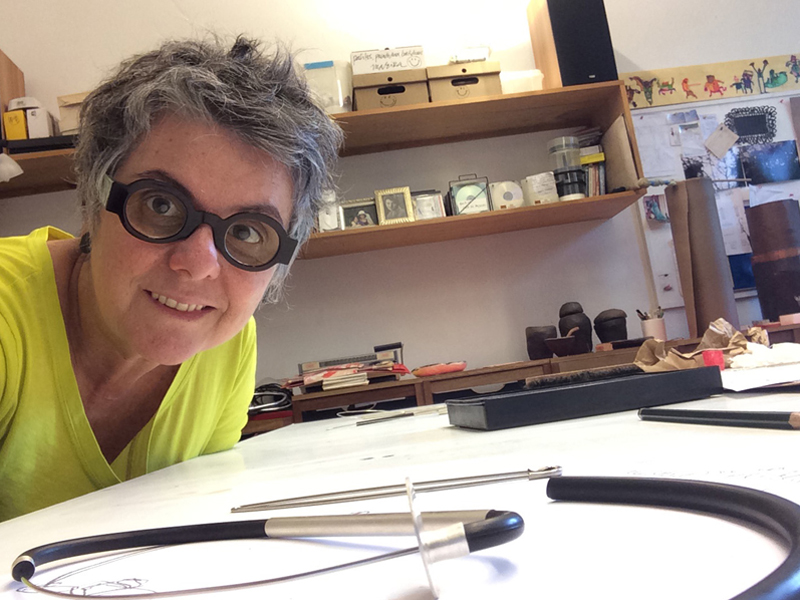
Marcia Cirne Lima describes her work as wearable drawings, the result of an interaction between rubber, silver, and steel—the flexibility, color, memory, resistance, and weight. Following her first solo show at Galeria Thomas Cohn, we interview her about what led to this current collection and what drives her work.
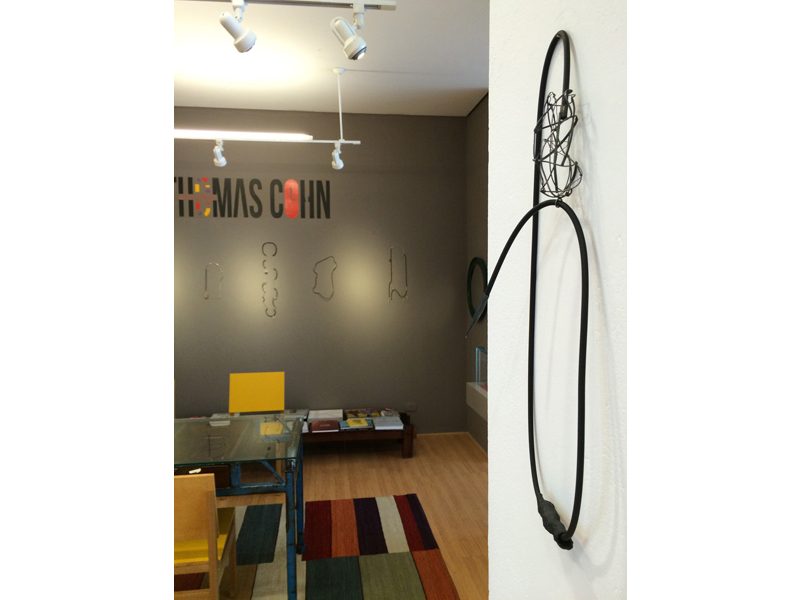
Sandra Wilson: What first attracted you to contemporary jewelry?
Marcia Cirne Lima: I was always interested in contemporary art, and when I started to make jewelry, my work was naturally influenced by concepts and aesthetics belonging to that art universe. I have worked with many things during my 57 years of life, including art, art teaching in secondary schools, training teachers of public schools in remote areas of Brazil, object design, graphic design, and, more recently, jewelry. That is, I gladly took what life offered me, that which awakened my curiosity. I believe the discovery of jewelry is some sort of gift I have received.
I have a strong link with Portugal; my husband is Portuguese, and we have many dear friends there. About three years ago, some of those friends gave me a large amount of cork oak pieces cured by plenty of sunshine, cold, and some rain after being left in the fields of Alentejo after the harvest, and challenged me to create something with that. I started to make cork necklaces. I felt I needed to add silver, and decided to take jewelry classes with professor Salvador Francisco Neto. I became completely absorbed by this work. I left all my other activities and today I’m fully dedicated to jewelry.
How would you describe your educational experience at Fundação Armando Álvares Penteado (FAAP)?
Marcia Cirne Lima: When I was 18, I believed FAAP was where you became an artist! During the four-year course I learned how misinformed I was. The school’s function is to train you in art; becoming an artist is a personal choice, a process that involves a lot of hard work and a fair amount of luck. Nevertheless, it was a meaningful experience, particularly due to the interaction with the great artists who taught at FAAP at that time.
What influence did the artist Carlos Fajardo have on the development of your work?
Marcia Cirne Lima: Fajardo is a superb artist, an excellent and generous teacher, and a very dear friend. He taught me to see contemporary art, recommended precious readings, and analyzed fundamental texts on art in study groups. And in particular, he assessed my work during the years I strived to grow as an artist. During this process, I learned to look at my own work from a distance to reflect on it, to formulate and reformulate what I was doing in search of nexuses, asserting poetic intentions, building consistency, and finding a field of interest that I could relate to.
Although I’ve given up the idea of becoming an artist, I sense a certain contentment when he looks at my jewelry—now that I’m no longer his pupil—which fills me with happiness and confidence.
You describe your work as having a poetic message and as drawings for the body—can you expand on this?
Marcia Cirne Lima: I’m not sure that poetic message is the correct term. Message may imply a text, a narrative, a story, and I don’t think my jewels have any of those. The poetic content they may have is in the relations among the materials, in defining what will be immobile or mobile, shorter or longer, pliable or rigid to generate resistance or realignment when used to allow different configurations of the same piece on the body.
There is a game where essential aesthetics prevails, although it is not minimalist, at least according to its definition in art.
Drawing is the backbone of what I do, either as a project, or as a reference, or result. I believe my jewels have a strong graphic quality, and the body of those who wear them becomes a sort of frame for these wearable drawings. It is on the body that my projects are fully completed and perfected.

The symmetry of this necklace from 2015, made of rubber and silver sections, is maintained by being worn on the front of the body. The equilibrium is broken if worn as a bandolier, as the rubber sections become distorted, creating small volumes on the body.
Do you consider yourself a modern-day alchemist? And how do you choose your materials?
Marcia Cirne Lima: I’d love to be a modern-day alchemist! Maybe one day …
For the time being, I feel more like a modern-times prehistorical collector. The rubber threads I used in the collection currently exhibited at Thomas Cohn Gallery, as well as the felt used for the packaging, come from a factory of insulating materials. The stainless steel wires come from dentistry and fishing material suppliers, and from haberdasheries. São Paulo is a crazy, giant city, with a wealth of contrasts, and I love wandering around seeking unimportant things. I set things I found and/or bought aside to be part of a project. Some have been in this limbo for many years. I have them close by in my working space and I once in a while see something that fits, which may be the beginning of a new game of transforming them into jewels.
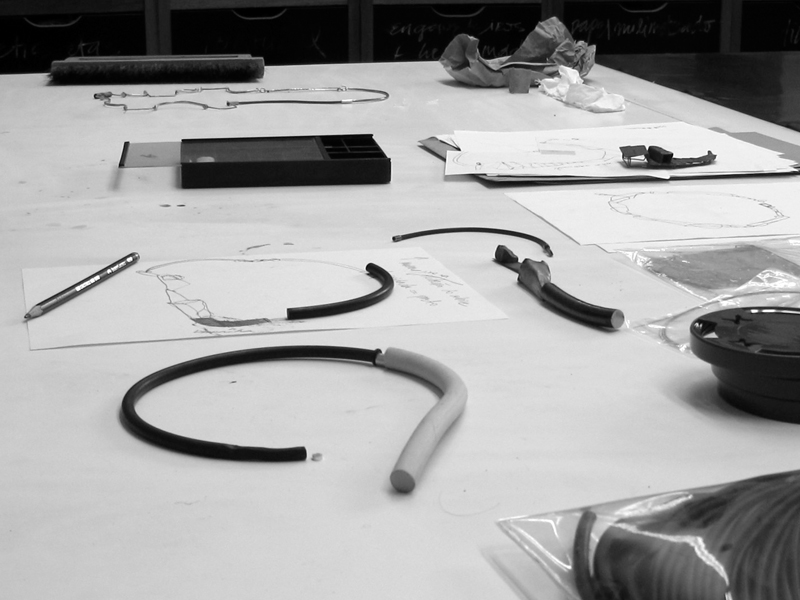
I also have some inspirational objects, usually chosen for their simplicity and ingenuity, like the safety pin I bought in an old haberdashery in Lisbon, which brought me to create some pins.
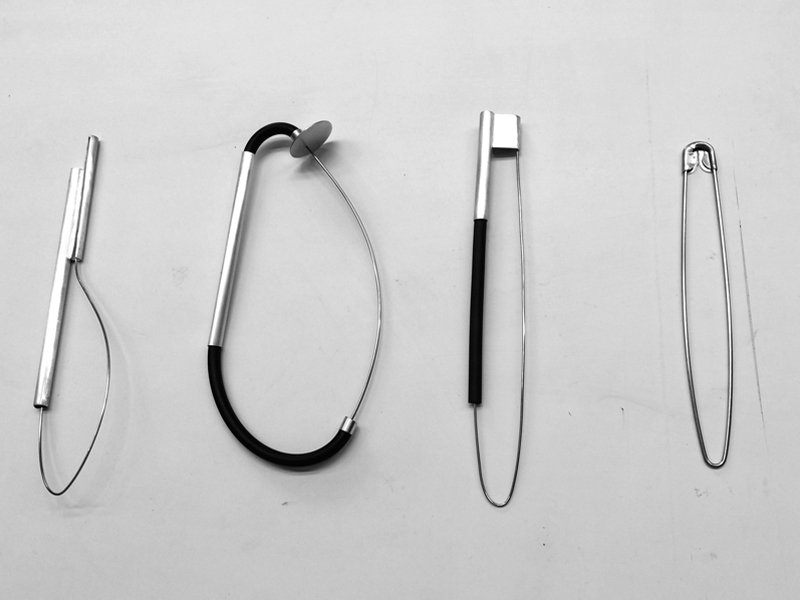
How important is the wearer to you in completing your work?
Marcia Cirne Lima: Thinking about jewelry being worn, imagining it on a body, predicting and testing possibilities is the strength of the design, of the functionality of each object I create. However, I don’t envision this functionality as that of a spoon, of a chair, where beauty is combined with comfort and efficiency. My jewels challenge those who choose them. However, this is not an imposition, rather an invitation to the wearer of a necklace or a bracelet to appropriate them, to become almost a co-author of the jewel. It is wonderful to see it happen.
This other necklace, in rubber and silver as well (2014), was designed to create curves and angles according to where on the neck you choose to carry it.
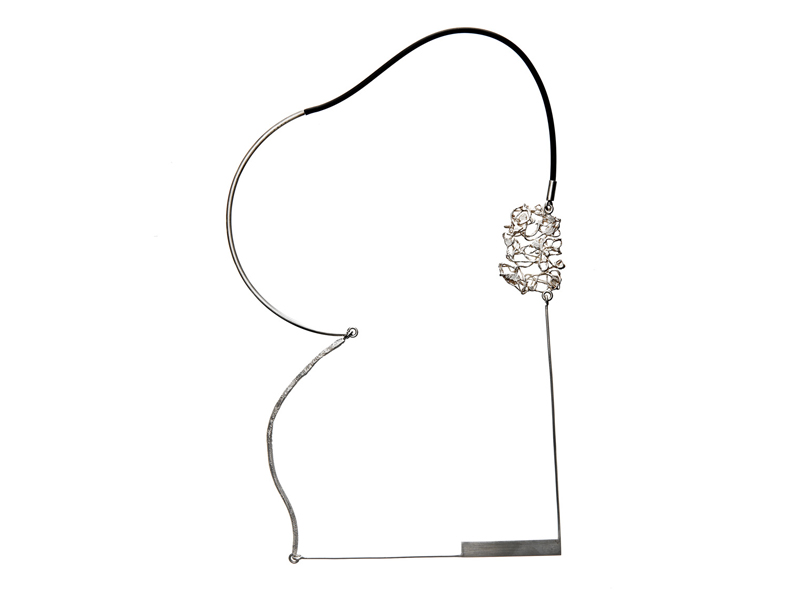
This necklace made in ceramic, rubber, and silver (2014) is another example of some possible changes while wearing it.
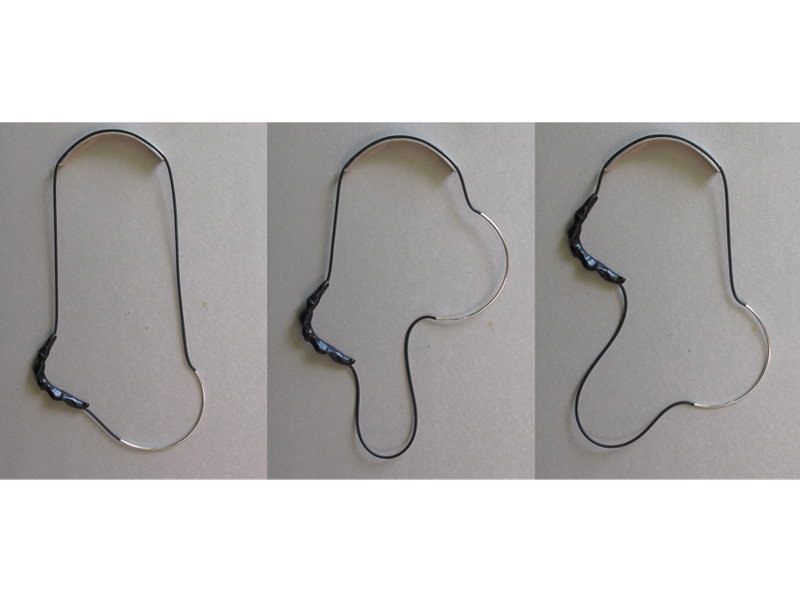
How did the opportunity to exhibit at Galleria Thomas Cohn come about?
Marcia Cirne Lima: It was sheer luck! I went to the opening of Sofia Björkman’s exhibition at the gallery wearing one of my necklaces. I do this sort of “test drive” to check the jewels’ comfortability and fragility, as well as their wearability in order to decide if they are truly finished. The necklace caught Thomas’s eye, he wanted to see more, I showed him other jewels, and he invited me to make this exhibition.
Thomas knows what he wants. When he chose his favorite pieces, I could clearly comprehend what he identified as the best quality in my jewelry. He is an art collector and gallerist who launched Brazilian artists in the market, like Adriana Varejão and Leonilson, who at the time were unknown and are now recognized as outstanding. I’m honored by his invitation.
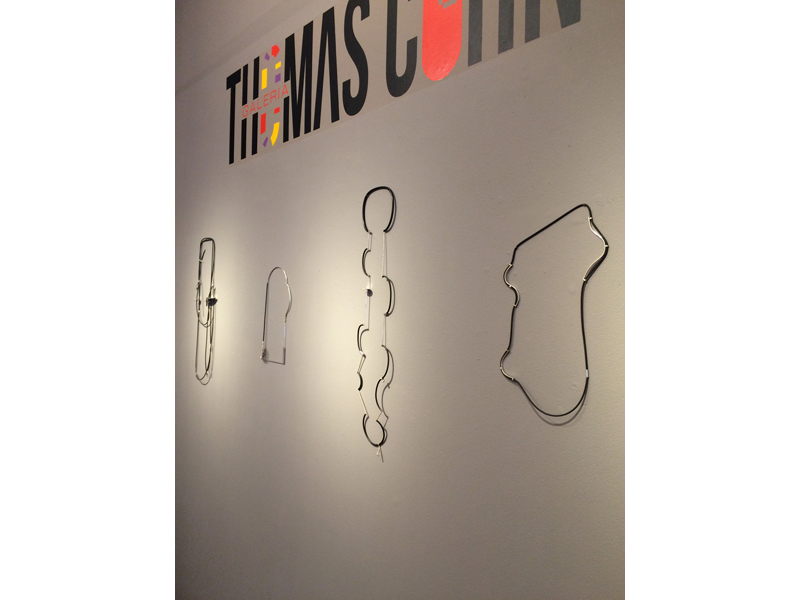
What do you think is distinctive about the contemporary jewelry emanating from Brazil?
Marcia Cirne Lima: I couldn’t tell, but I’m somewhat suspicious of the “Brazilianness” conceptions that assume that we need to necessarily use the materials provided by our forests or allude to tropical themes. Such rules, which are external to the process of the constitution of each work, tend to disguise quality on behalf of the defense of some cause or other. In fact, I’m more interested in universal endeavors and things we find in different places. The Baniwa, indigenous people of the Amazon, make an object we call “rodilha” or trundle, which is a cloth ring worn on the head to carry pots. These contraptions are the same as those found in Portugal, Africa, and elsewhere. The materials may be different, but they are identically made and used. It is human ingenuity that brings us closer together, independently of our specificities and similitudes. It is beautiful and extraordinarily interesting!
This is a photo I took of the Baniwa trundle I have at home.
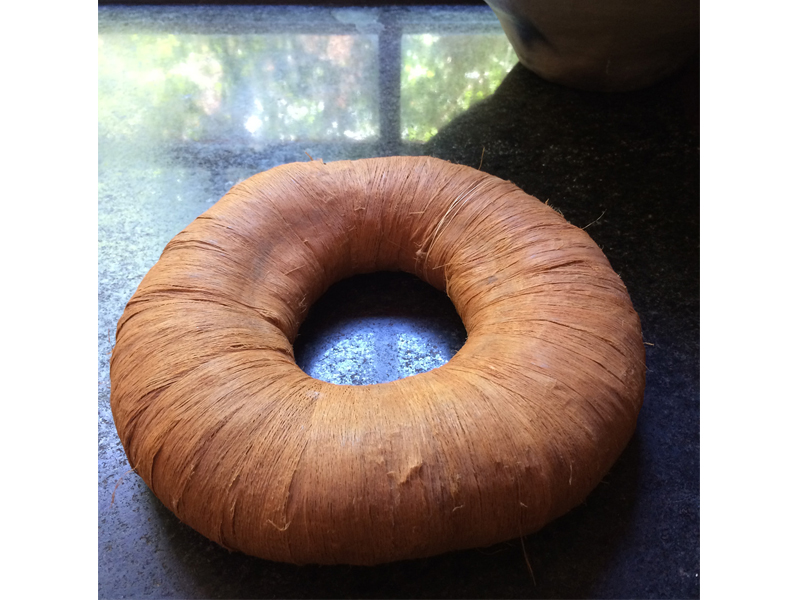
An African trundle made in a different way with material but for the same purpose.
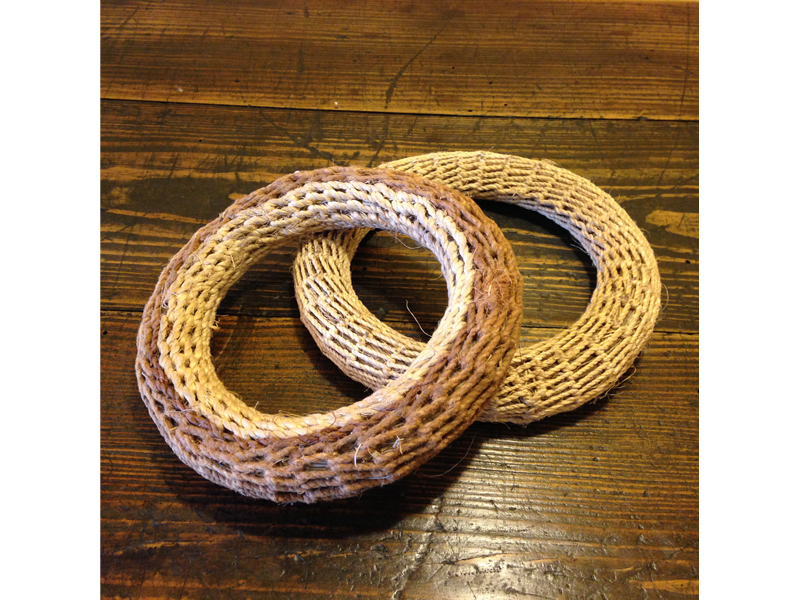
Moreover, I believe that the concept of contemporary jewelry is still not fully acknowledged here in Brazil and we need more jewelry exhibition spaces and time to determine which aspects may characterize Brazilian contemporary jewelry.
In what ways do you think contemporary jewelry needs to evolve?
Marcia Cirne Lima: I would like to answer this question from my individual perspective. My goal is to maintain, virtually as method, the tension between the function of use and the poetic function and to be able to increase my knowledge on techniques, materials, and procedures to create new challenges and to allow broader choices in my work.
What would most support your growth and development as a contemporary jeweler?
Marcia Cirne Lima: Most of all, to immerse myself in the studio and to wander farther away. To attend courses, make partnerships, see jewelry, listen to jewelers and their experiences, and take in jewels, take in jewels … The aim is not to build a repertoire, to gather references, but to learn from aesthetic experiences. It is more or less like walking around Richard Serra’s sculptures instead of just seeing pictures or watching films of the work of this brilliant artist. Maybe the one I love best.

Do you engage with the jewelry discourse, and if so, what things do you read—in print or online?
Marcia Cirne Lima: I do not know much. I visit websites like klimt02, bijoux contemporain, and AJF, of course, but all this is very recent for me. Thomas encouraged me to follow the discussions because he knows it is important to know what our peers think and, perhaps, because we healthily disagree on the idea of jewelry as art. I believe art is art; it only has a poetic function; it is a place of uneasiness. On the other hand, jewels are wearable, but they may also carry a significant poetic content, if the author so determines. This is the difference between art and jewelry from the conceptual perspective, and it is precisely the coexistence of these two functions in jewelry that interests me. Such assertions are sometimes challenged, by the Parangolés of Hélio Oiticica, wearable works created in the 1960s with members of the samba school Mangueira in Rio de Janeiro. The fact is that the craziest necklace is still a necklace while on the table, whereas a Parangolé exhibited as an object is in the absence of a body to make it move, to make it happen.
Film extracts with Parangolés shown at Tate Modern in 2007: https://www.youtube.com/watch?v=dJTr8I2M6Ps.
In your own teaching, what knowledge and skills do you aim to pass on to the next generation of makers?
Marcia Cirne Lima: I taught art in secondary school and in elementary school teachers’ training courses in art in northern Brazil. My focus was to show teachers that aesthetic experiences may be learning experiences and to help them to plan lessons where pupils were the protagonists of these experiences. My proposal was to make pupils look at the same things a determined artist looked at, and through this personal experience, to collect elements to allow them to understand the work of the artist when in contact with it, thus eliminating the need for anyone to decipher it for them. The effort here is to avoid considering imitating art works as the right thing to do, and at the same time to create a culture of courage to leap into the abyss that is the art work you see for the first time.
I left this universe eons ago, but art is still vital to me; it is the backbone of my own academic background and somewhat impregnates everything I do.
Thank you!




